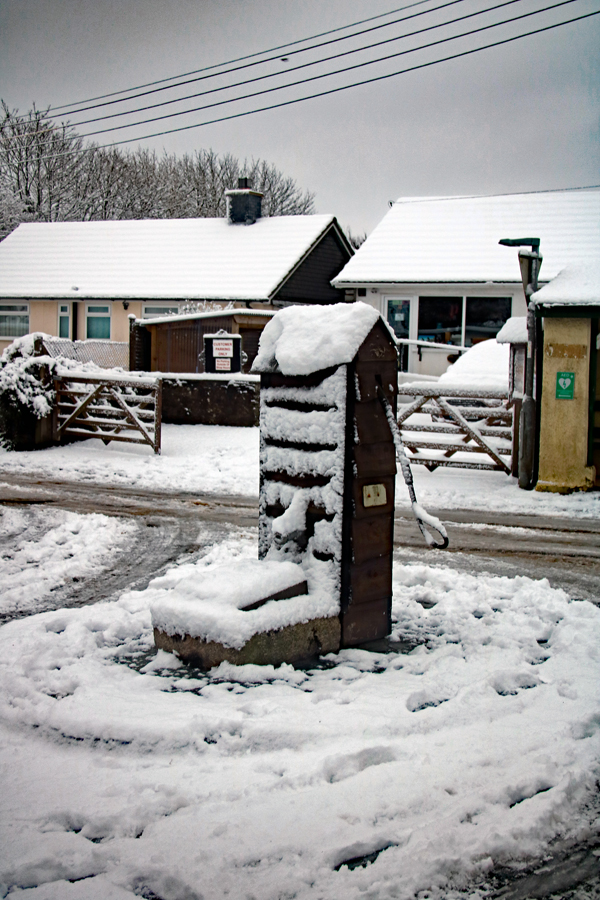.
With special thanks to Michael and Phyllis Aunger.
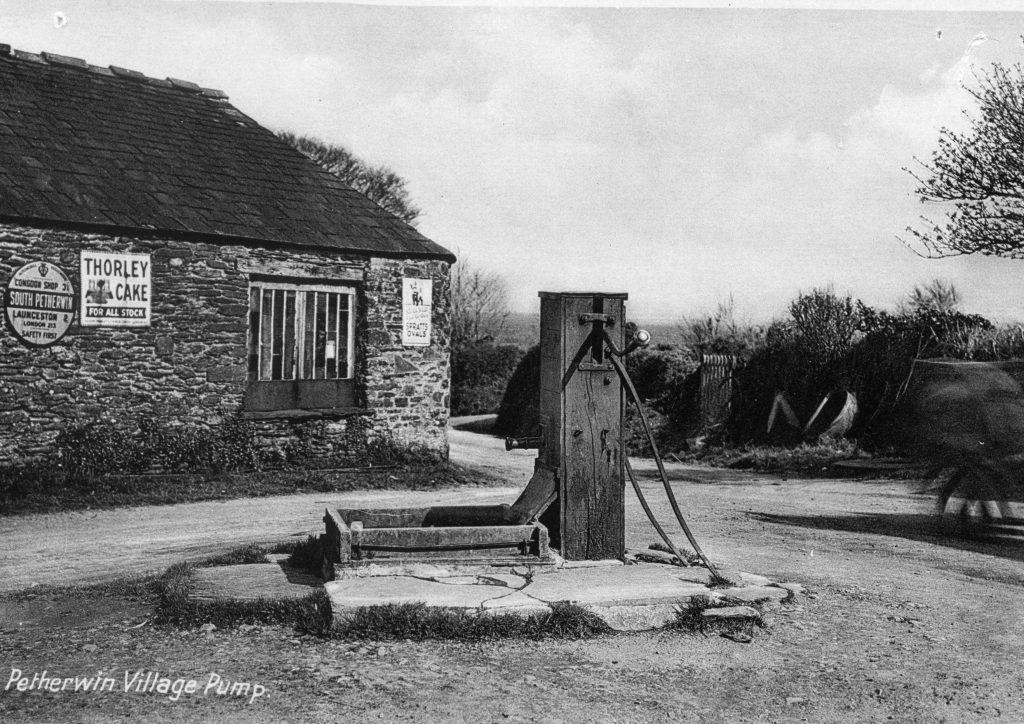
Standing in the centre of South Petherwin on the corner of the junction between the main B3254 Launceston to Liskeard road and Trewarlett road is the old village pump. It is much changed from the original and is no longer in working order, standing as it does as a monument to a bygone past. But for generations, it was the main source of the village’s water.
The first account or mention of the pump which was at a meeting held in 1884. The first committee was made of W. Werring, T. Stacey, S. Wilton, F. Walters, W. Voeden and W. Harris. The minutes state that the pump was bought in that same year (possibly from Prockter and Kent), and probably built over an established well. Also at that first meeting, an order was issued by the committee “that no water shall be used in scarcity time but for put use.” James Stacey was given the responsibility to look after the pump, being paid 10 s. 3d. Later in the year, Mr J. Beare was paid 10 s. for cleaning out the pump ‘pit.’
A rate was set by the committee for the villagers to fund the upkeep and running of the pump starting in 1884 where a total of £2 16 s. 8d. was collected with an outgoing of £2 11s. 1d. leaving in hand 15 s. 7d.
South Petherwin Village Pump Payment Book 1899-1914.
South Petherwin Village Pump Payment Book 1899-1914Over the years the pump required a considerable amount of maintenance to keep it running, with Prockter and Kent being the main contractor although the first known payment to them was in 1910 when a bill for 7 s. 6d. was settled. By then a figure of £2 10 s. 9d. was carried forward in the accounts. In 1912, the pump was replaced with a new one supplied by Prockter and Kent at a cost of £2 2 s. although for some reason this bill was not settled until 1917 (possibly due to the committee not meeting in that time), where it was mentioned in the committee meeting held on November 17th. The committee by then comprised of Messrs W. Werring, R. Maddever, Jas. Stacey, Jas. Strike, Thomas Cheeseworth, Rt. Hicks and J. M. Gunner (chairman). At this meeting, W. J. Stacey resigned from his office of the collector with Rt. Hicks being elected to replace him. He was to be paid 2/6 per annum for his services. It was also agreed at the meeting that the rate would be collected half-yearly in the future and the rate was to be 1/6 to conclude the contract to be collected at once. The following years meeting reported, “that the wood-work of the pump was in a weak condition and the drain chocked.” With that South Petherwin carpenter, Richard Maddever was engaged to repair and replace the wood-work. The total cost of the work was £6 5 s. 9d. with a further cost from Prockter and Kent of £2 13s. 3d.
It was agreed to ask the owners of property whose tenants used the pump to also pay subscriptions towards the expenses at the 1919 meeting held of December 16th. Mr Stacey proposed and Mr Maddever seconded that a rate of 1/- for 1919 is collected right away and that a further rate be levied when the list of subscriptions was completed. An amendment was proposed by Mr Hicks and seconded by Mr Webber that no rate be levied until the number of subscriptions from landowners was known. In the end, Mr Stacey’s proposal won the day by four votes to three. With the in hand funds unable to meet the full list of debts, it was agreed by the committee to pay just those for the collection of the rates, deferring the repair costs until the following year. However, the following year the Treasurer reported that he had only had one reply from a landowner, so on the proposition of Mr Strike it was agreed to make a rate of 3/- (with an allowance for widows) to pay off the outstanding repair balance of £8 19/-.
Owing to a long hot summer and the well running dry, a general meeting was held on September 7th, 1921. A large number of people attended to learn that the pump was to be locked throughout the day and to open for an hour in the evening from 7 p.m. to 8 p.m. (Sundays 4:30 p.m. to 5:30 p.m.). Each person was to be allowed one turn only with the restrictions being in place for as long the drought continued. Mr J. Ball was put in charge and was paid 5/- per week for his services. The scarcity of water was again an issue two years later when a complaint was made at the committee meeting held on September 14th, 1923. Here it was alledged that “much water was being used for building purposes.” It was agreed that a notice be put on the pump stating that during the “present scarcity” no water may be taken except for household purposes. Over the next thirty years, further summer droughts continued to cause a ‘scarcity’ of water in the well, with restrictions again being employed to save the dwindling supply.
By 1924, the pump committee consisted of Messrs J. Strike, J. Webber, J. Ball, S. Wilton and J. Gunner. At that year’s meeting held on May 27th, a letter was read out from the District Surveyor stating that the drain from the village pump was chocked and he asked that the committee repair it. He agreed that once this had been done, he would put a load of stone over the road. On a motion proposed by S. Wilton, it was agreed to ask Mr J. Ball to carry out the work. It would be another 18 months before the next meeting where it was announced that the well had been dry since the middle of September, so it was decided to ask a plumber to examine the pump which was carried out by Mr J. Broad. He found the valves in the ‘pit’ to be the cause of the problem and once taken off and refixed the pump was again working. The cost of these repairs was 7/-. At the next meeting held on September 26th, 1928, it was reported that the wood-work was worn and it was agreed to ask Mr R. Maddever to repair the same and to put on a new chain for the drinking cup. At the same time, Mr J. Webber was asked to repair the stone step. The total cost of these repairs was £5 6s. 2d. By now the balance in hand stood at £13 9s. 10d. During the 1920s, various minor repairs were made to the pump, such as repairing the leather sucker for which Prockter and Kent were called on to complete the work. In April 1931, they were employed to carry out a major refit of the pump, entailing a total cost of £8 12s. 6d.
Unfortunately, there are no surviving committee meeting minutes (possibly due to no committee standing during that period) for the ten years between 1928 and 1938, but from the receipts and expenditure, we can see that the pump finances such as those of 1931 were continued to be administered. By 1938 the balance in hand stood at £ 6 14s. 8d. Again, this was another year of drought and in the meeting minutes of May 13th, we see a discussion between just six attendees at what to do. It was suggested to pass the problem across to the Parish Council, but this was considered impracticable. The meeting then decided to form themselves into a committee, viz. Messrs S. Wilton, G. Symons, J. Webber, J. Strike, F. Hicks and J. Gunner. As there had been a shower on that day, it was decided not to lock the pump immediately and to call the committee to a meeting when necessary. There are no minutes covering the war years, but we can see from the expenses that again the pump committee continued to administer the accounts with the balance in hand standing in 1945 at £15 13s. 5d. That year, plumbers T. Chapman of Launceston carried out repairs to the value of £1 7s. 6d.
A general meeting was held on August 27th, 1947, to appoint a new treasurer, after the death of Mr J. Gunner. Mr J. Wilton was also retiring from being the rate collector. The committee was made up of Messrs G. Hicks, J. Strike, E. Neale, W. Congdon, H. Jenkins, Walter John Aunger and W. Cheeseworth. Mr E. Neale was appointed collector with Mr Aunger the treasurer. The rate was fixed at 2/- per half-year where there was a man in the house, and widows to pay 1/- per half-year. The balance in hand stood at £2 16s. 7d. after major work had been carried out by South Petherwin carpenter Mr A. H. Cheeseworth, to a total cost of £11 2s in June of that year.
South Petherwin Village Pump Payment Book 1951-1965.
South Petherwin Village Pump Payment Book 1951-1965Just before 26th March 1949, the pump stopped working and after an investigation by T. Chapman, it was found that the sucker leather had become worn this was replaced at a cost of £2 11d. but about a fortnight later, the pump again stopped working, and again the sucker leather was one of the causes, but this time the connecting rod had broken. After three days of being out of action, a temporary iron rod was fitted until a new steel rod was permanently fixed. The total cost for this second repair was £10 11 s. 9d. In a meeting held at the beginning of November 1949, it was announced that a notice had been fixed to the pump by Mr Judd the Sanitary Inspector of Launceston, stating that the water was unfit for drinking water unless boiled. A further public meeting was held later in the month to discuss the issue. Held in the W.I. Hall on November 23rd, it was decided to wait for the results of a second test that had been taken a week before. A letter was sent to Mr Judd in February 1950, asking for a further test to be completed which came back advising that the water still grossly polluted and unfit for drinking unless boiled (The test showed that the water contained a probable number of coliform bacilli, MacConkey 2 days, 37° C. of 600 per 100 mls.).
Water Sanitary Reports 1950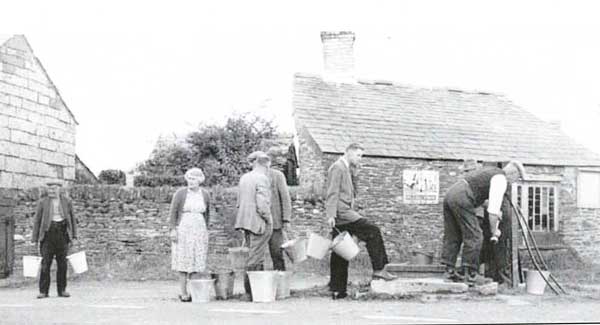
Over the next few years, minor repairs were carried out to the pump (mainly the sucker leather). The biggest repair coming in August 1955, when R. Maddever again replaced and repaired the woodwork around the pump to a cost of £4 15s. 6d. It was also found in August of that year, that again after a drought, the water level in the well was standing at approximately just 3 feet 6 inches, and it was decided to again lock the pump during the day, inlocking for one hour in the evenings. Each household was allowed just two buckets per day. Although another dipping of the level on September 3rd showed that the level had risen by a foot, it was decided to keep the restrictions in place until further rainfall. It wasn’t until November 12th that sufficient rainfall had allowed the water level to rise, that the restrictions were lifted and the pump was unlocked. In total, the restrictions had lasted for eleven weeks.

Major repairs were made to the pump in May 1956 totalling £7 10s. with the work again being carried out by Launceston plumbers W. J. Chapman. The final invoice for repair came in June 1958, when Chapmans replaced the sucker leather for one last time at a cost of £2 1s. 3d. This would be the pumps final year of use and the balance in hand in 1958 stood at £29 4s, 3d. But with mains water now available in the village in 1958, the burden for water now no longer fell on the little well and its pump. So after some seventy years, the pump lay idle. With the payment of outstanding bills the total on hand at the end of 1958, stood at £6 17s. 8d. A further bill of £6 11s. 7d. for work carried out by Richard Maddever in June 1962, then left a total of 6s. 1d.
One final meeting was held on November 4th 1965, when at a public meeting, Mr Phillips, the R.D.C. chairman asked the Parish Council to try and tidy the surround of the village pump, suggesting a small wall with a grass centre or the equal. A proposal by G. Harris and seconded by L. White, to keep the pump as a monument was passed. This final meeting was held with J. Strike, H. Jenkins, G. Harris, and J. Aunger, all committee members. Also, present, representing the parish council was the Rev. R. A. L. Hesketh and L. White. The meeting was held in the W.I. Hall and for the use of its kitchen, the committee was charged 5s. leaving a final balance in hand of 1s. 1d.
South Petherwin Village Pump Meeting Minutes 1892-1965
South Petherwin Village Pump Invoices 1913-1958
South Petherwin Village Pump Bank Statements 1949-1958
In 1969 the Parish Council paid for the pump, now no longer connected, to be restored by J. Edwards and R. Maddever. A plaque was attached at the time which states:
Restored 1969 for the Parish Council by J. N. Edwards and R. Maddever. In 2014 it again underwent restoration, with the woodwork being replaced by A. Hoskin and P. Parsons.
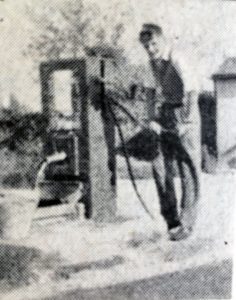

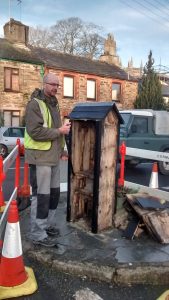

Above Andrew Hoskin restoring the pump in 2014.
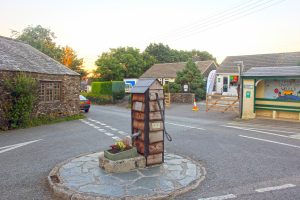
South Petherwin Village Pump Winter 2019.
Visits: 131

